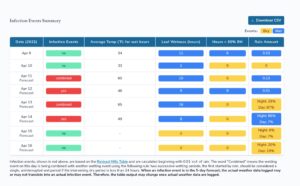The only thing predictable about Indiana weather is that it will certainly be unpredictable! The past few weeks of cool weather and intermittent freezes has slowed some things down. Unfortunately, scab isn’t one of those things.
Failure to control early season scab infections increases the risk of economic losses. When managing scab, it is important to realize that ascospores don’t all ‘shoot’ at once but occurs over a period of weeks to months, depending upon the weather. As the temperature warms and snow turns to rain, fruiting bodies (called pseudothecia) develop on the leaf litter. As the fruiting bodies mature, they release ascospores when temperatures are above 50 degrees WITH rain (more than 1/100th of an inch). As you can see from the NEWA station, the process is only beginning:

The rate of ascospore maturation and release follows a bell curve—they increase, reach a peak, and then decrease.

Infection events are shown in red below. Even though we are only at green tip to half-inch green, we have had four infection events. We used copper to knock down scab and keep it from getting a toehold in the orchard. This protects against scab while allowing us to preserve our captan and mancozeb as disease pressures increase in the coming days and weeks.
As per the NEWA website: “Infection events, shown in red above, are based on the Revised Mills Table and are calculated beginning with 0.01 inch of rain. The word “Combined” means the wetting event on this day is being combined with another wetting event using the following rule: two successive wetting periods, the first started by rain, should be considered a single, uninterrupted wet period if the intervening dry period is less than 24 hours. When an infection event is in the 5-day forecast, the actual weather data logged may or may not translate into an actual infection event. Therefore, the table output may change once actual weather data are logged.”
How to manage early season scab?
Early season sprays are critical for controlling scab. Without these spray interventions, the cool and wet weather pattern is setting the stage for potentially big outbreaks of scab.
First and foremost, check buds for damage if the weekend freeze was an issue. Without a crop, spraying can obviously be curtailed. In the south, these freezes may have caused anything from a little thinning to significant damage, depending upon location, cultivar, and growth stage. In past years, we found 100% loss after examining a hundred buds…but still had a decent crop on Rosalee. 🤷♀️All of us have been surprised to find apples after a significant freeze so I really caution giving up too early!
Second, assuming you still have a crop, begin weekly or even more frequent monitoring of orchard blocks to determine growth stage, pest activity and weather. Continue monitoring weather conditions for apple scab infection periods and spray accordingly. Early season sprays should rely more heavily on captan, mancozeb, Syllit, Scala, Vanguard, and some of the SDHIs, like Fontelis. I would save Aprovia for later use, as it is the one SDHI fungicide that is effective against bitter rot management later in the season.
Third, it’s important to note that a well-managed orchard with 1% leaf scab or less would still produce ~900,000 ascospores per acre. In an unmanaged or poorly managed orchard (due to crop loss), a greater number of ascospores will be released with rain events, and scab levels will uptick, resulting in up to billions (with a B) of ascospores per acre (Gadoury and MacHardy (1986), an increase of more than 5000-fold.
Even if only a small percentage of the total number of ascospores are being discharged now—1% of 5 billion still leaves us with 50 million ascospores, more than 50 times what would be present in a ‘normal’ year.
If any of these ascospores successfully infect at green tip, conidia will also be adding inoculum when flowers, fruit and leaves are most susceptible. These small numbers of ascospores that result in successful infections now (green tip, half-inch green) increase the likelihood of conidia before petal fall, exacerbating the risk of fruit scab.
Finally, because of this epic spore load, it may seem as if fungicides aren’t as effective. Unfortunately, the numbers game we are playing is the problem, not necessarily the fungicides. Most fungicides are ~99.999% effective (a 5-log kill). Using any fungicide against our 1% spore load of 50 million (1%) still leaves us with 500 spores capable of infecting—and that is assuming perfect coverage. Of the 500 surviving ascospores, each one can create a lesion producing 95,000 conidia per day.
Obviously, the apple scab house rules definitely favors the fungus! If you were unable to get urea onto your orchard floor in the fall or spring (see FFF #1-18 for more info for next year!), you can improve fungicide efficacy with higher rates, tighter intervals and improved coverage, until the weather turns hotter and drier.
There are many factors that contribute to ‘bad’ apple scab years. Keep in mind that every day of dry weather after bud break delays scab development in trees by one more day. If your weather is dry prior to tight cluster or even pink, the earliest primary infections occur too late in the season. This means that you avoid the repeating cycles of secondary spore production PLUS apple leaves and fruit also become less susceptible to scab. Furthermore, ascospores mature and develop but remain stuck in the fruiting body, never to be released. Unfortunately, at least for us in most of the state, as long as the weather remains cool and wet, trees must be protected from the threat of early season scab.

